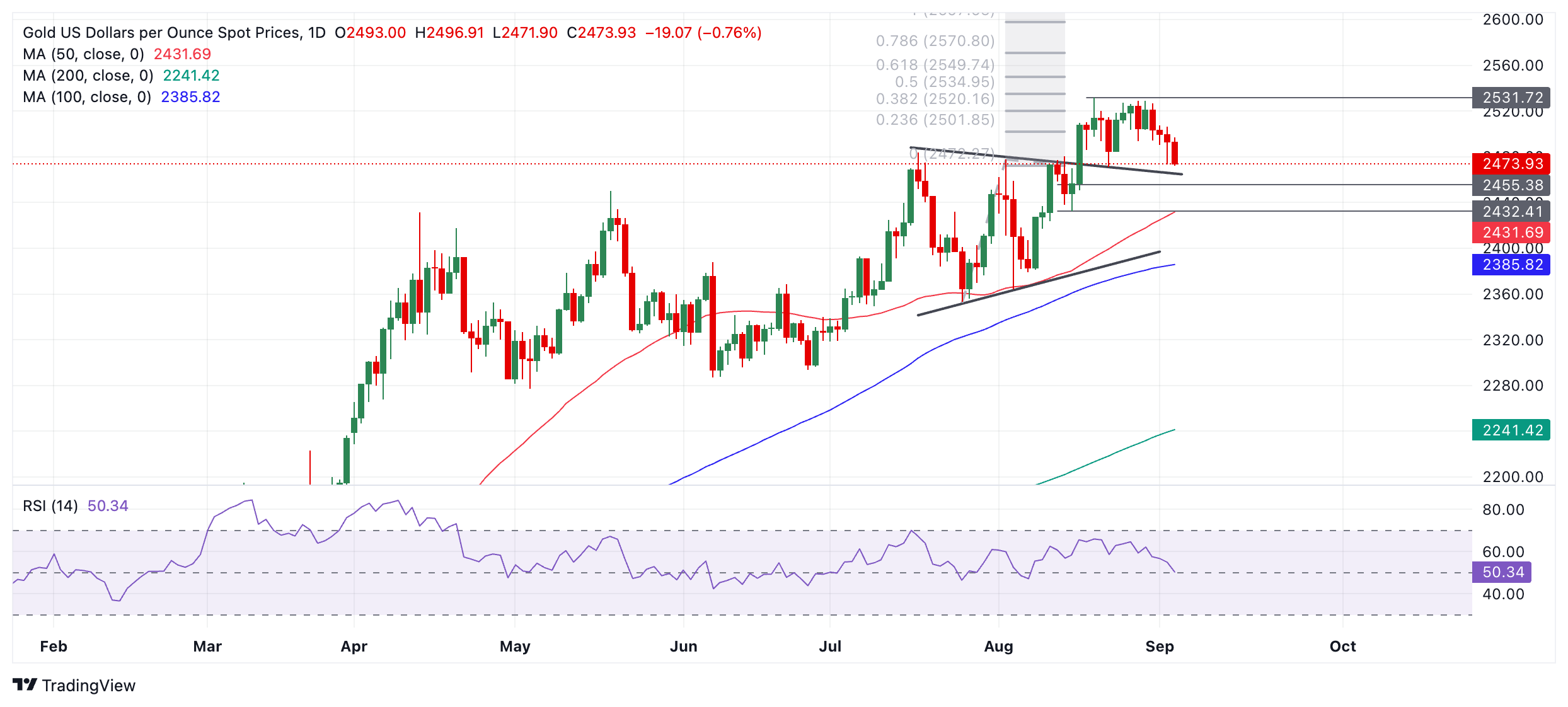- Gold continues to fall despite risk sentiment turning negative following weak US manufacturing data
- Excessive long positioning could be the reason why the commodity is not rising as expected.
- Technically, Gold has broken below the key $2,500 level – a bearish signal for the precious metal.
Gold (XAU/USD) is trading lower, trading at $2,480 on Wednesday. Market sentiment remains negative following the global sell-off triggered by the release of weak US manufacturing data on Tuesday, and fears over the bursting of the Artificial Intelligence (AI) tech bubble.
Surprisingly, this has not translated into a rally in Gold despite its safe haven status, perhaps due to excessive long positioning by Commodity Trading Advisors (CTAs) and institutional investors. Despite the turmoil affecting risk assets, Gold ended Tuesday down more than a quarter of a percentage point.
Gold shrugs off rising odds of 0.50% Fed rate cut
Gold also fails to capitalize on the significant increase in market-based odds that the US Federal Reserve (Fed) will opt for a larger interest rate cut of 0.50% at its September 18 meeting.
Before the release of the weak US manufacturing PMI, the CME FedWatch tool – which uses the price of 30-day federal funds futures to estimate the likelihood of future Fed decisions – put the probability of the Fed making a 0.50% cut at around 31%. Today the probability has risen significantly to 41%.
Such a large shift in expectations of a fall in interest rates would normally be expected to have a bullish effect on gold, as it reduces the opportunity cost of holding the non-interest-paying precious metal. However, this does not seem to be the case on this occasion.
US employment indicators, scheduled for release later in the week, could still impact the US interest rate outlook either way. This is particularly relevant given recent comments from Federal Reserve (Fed) Chairman Jerome Powell, who highlighted risks to the labor market as now more important than inflation in his Jackson Hole speech. This week’s data will put his statements to the test.
On Wednesday, the US JOLTS job openings are due to be released, which are forecast to show a decline to 8.1 million in July from 8.184 million in June. However, a sharper decline in job openings would heighten concerns about the state of the labor market and further increase the likelihood of a Fed cut larger than 0.50%.
ADP employment change and jobless claims will follow on Thursday, but the main event on the calendar will be US nonfarm payrolls (NFP) on Friday. If NFP rises less than expected, it would further support the case for a larger cut.
On the geopolitical front, there are no major flare-ups that could translate into increased demand for gold. Although Russia launched a major missile and drone attack on Ukraine on Tuesday, killing 50 people in Poltava, it follows days of similar bombings.
Meanwhile, in Gaza, Israelis continue to protest for a ceasefire to allow for the safe release of hostages, and the US has criminally charged Hamas leaders with organizing the October 7 attacks.
Technical Analysis: Continues to oscillate in a disorderly range
Gold (XAU/USD) continues to wander within a disorderly range below its previous all-time highs of $2,531.
It has now broken below the key support level of $2,500 – a bearish turn of events from a technical perspective – but remains above the next key level at $2,470-$2,460, the top of the old range formed in July and early August.
XAU/USD Daily Chart
An as-yet-unreached upside target for Gold stands at $2,550 and remains active. This was generated after the original breakout of the July-August range on August 14.
Gold’s medium- and long-term trends also remain bullish, which, given that “the trend is your friend”, means that the odds still favor the materialization of an eventual breakout to the upside.
A break above the August 20 all-time high of $2,531 would provide further confirmation of an upside continuation towards the target of $2,550.
However, if Gold continues to weaken steadily, it is likely to find support at the $2,470-$2,460 level. A decisive break below that level would change the outlook for Gold and suggest that the commodity could be starting a more pronounced downtrend.
Economic indicator
Nonfarm payrolls
The most important result contained in the employment situation report is the monthly change in non-farm payrolls published by the US Department of LaborThe report publishes estimates of job creation for the previous month and revisions to the data for the previous two months. Monthly changes in payrolls can be very volatile and the release of this report generates high volatility in the dollar. A result above the market consensus is bullish for the dollar, while a result below expectations is bearish.
Next post: Fri Sep 06, 2024 12:30 PM
Frequency: Monthly
Dear: 160K
Previous: 114K
Fountain: US Bureau of Labor Statistics
The US monthly employment report is considered the most important economic indicator for currency traders. Released on the first Friday following the reported month, the change in the number of employees is closely linked to the overall performance of the economy and is monitored by policymakers. Full employment is one of the Federal Reserve’s mandates and it considers developments in the labor market when setting its policies, which affects currencies. Despite several leading indicators shaping estimates, Nonfarm Payrolls tends to surprise markets and trigger substantial volatility. Actual figures that beat consensus tend to be bullish for the USD.
Source: Fx Street
I am Joshua Winder, a senior-level journalist and editor at World Stock Market. I specialize in covering news related to the stock market and economic trends. With more than 8 years of experience in this field, I have become an expert in financial reporting.








